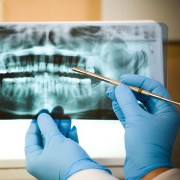 Photo: Getty Images
Photo: Getty Images
In my previous article I discussed mercury and vaccines as possible causes of autism. Now, I will look at elements that babies are exposed to in the womb that may predispose them to getting autism.
Mercury Amalgam Fillings
Mothers who have mercury fillings, which contain 50 percent mercury, when pregnant, or who have them before pregnancy, may have an increased risk of having a child with autism. Although mercury fillings have been used for more than 150 years, the safety of such a practice was not studied until recently.
A review published in 2009 found that:
"Mercury from maternal amalgam fillings leads to a significant increase of mercury concentration in the tissues and the hair of fetuses and newborn children. Furthermore, placental, fetal, and infant mercury body burden correlates with the numbers of amalgam fillings of the mothers. Finally, mercury levels in amniotic fluid and breast milk correlate significantly with the number of maternal dental amalgam fillings." (1)
So pregnant women who have mercury fillings could end up leaching mercury into their amniotic fluid and passing it through the placenta to give their babies' bodies burdensome amounts of mercury before they are even born.(6)
If the mother has the fillings removed during pregnancy, this can make the situation worse and cause more mercury to be released. When she begins to breast feed, her baby gets additional mercury from the milk. A study in sheep found that after ewes were given new amalgam fillings and they nursed foster lambs, the lambs received some of this mercury.
"Neonatal uptake of mercury (Hg) from milk was examined in a pregnant sheep model, where radioactive mercury (Hg203)/silver tooth fillings (amalgam) were newly placed. A crossover experimental design was used in which lactating ewes nursed foster lambs. Results from the animal studies showed that during pregnancy, a primary fetal site of amalgam Hg concentration is the liver and after delivery, the neonatal lamb kidney receives additional amalgam Hg from mother's milk. It was concluded that Hg originating from maternal amalgam tooth fillings transfers across the placenta to the fetus, across the mammary gland into milk ingested by the newborn, and ultimately into neonatal body tissues." (2)
Anti-D injections
Anti-D injections are given to rhesus (Rh) negative mothers during pregnancy to reduce the risk of fetal Rh (positive blood mixing with theirs and causing an immune system reaction). This is called rhesus disease or feto-maternal haemorrhage.
This can occur during childbirth but mainly occurs if the mother has had an invasive medical procedure such as amniocentesis or chorionic villus sampling. Feto-maternal haemorrhage can cause the baby to become anemic and need an in utero blood transfusion, which carries a 2 percent risk of fetal death. (3,4)
However, some brands of anti-D injection used to contain mercury and it has been implicated as a possible cause of autism. A 2008 study by the Institute of Chronic Illnesses found that Rh-negative mothers were much more likely to have children with neurological disorders, compared with Rh-positive mothers.
Thimerosal was removed from the U.S. anti-D injections in 2002 and researchers discovered that the children born in 2002 or later had the same risk of neurological disorder as those in the Rh-positive group, but those before 2002 had a higher risk, suggesting that the anti-D injection was the causative factor.
"There were significant and comparable increases in maternal Rh-negativity among children with NDs (Clinic: A=24.2 percent), autism spectrum disorders (Clinic: A=28.3 percent, B=25.3 percent), and attention-deficit-disorder/attention-deficit-hyperactivity-disorder (Clinic: A=26.3 percent) observed at both clinics in comparison to both control groups (Clinic: A=12.1%, B=13.9 Percent) employed. Children with NDs born after 2001 had a maternal Rh-negativity frequency (13.6 percent) similar to controls." (5)
Removing the mercury from anti-D injections seemed to be a positive step in reducing the number of children with autism and ASDs.
Sources:
1. A prospective study of prenatal mercury exposure from maternal dental amalgams and autism severity, Acta Neurobiologiae Experimentalis. Acta Neurobiol Exp 2009, 69: 1–9.
Abstract: http://www.iaomt.org/news/files/files302/Amalgam_Autism_Geier_2009.pdf
2. Vimy MJ et al., Mercury from maternal "silver" tooth fillings in sheep and human breast milk. Biol Trace Elem Res.1997 Feb;56(2):143-52. Abstract:
http://www.ncbi.nlm.nih.gov/pubmed/9164660
3. Birth Defects, Rh Disease, March of Dimes. Web. 9 September 2011. http://www.marchofdimes.com/birthdefects_rh.html
4. A156 Pregnancy (rhesus negative women) - routine anti-D (review): guidance, National Institute for Health and Clinical Excellence. Web. 9 September 2011.
http://guidance.nice.org.uk/TA156/Guidance/doc/English
5. Neurodevelopmental disorders, maternal Rh-negativity, and Rho(D) immune globulins: a multi-center assessment, Neuroendocrinology Letters. 2008 Apr;29(2):272-80. Abstract:
http://www.ncbi.nlm.nih.gov/pubmed/18404135
6. Lugliè PF et al. Mercury determination in human amniotic fluid. Minerva Stomatol. 2000 Apr;49(4):155-61.
Abstract:
http://www.ncbi.nlm.nih.gov/pubmed/11040541
Joanna is a freelance health writer for The Mother magazine and Suite 101 with a column on infertility, http://infertility.suite101.com/. She is author of the book Breast Milk: A Natural Immunization, and co-author of an educational resource on disabled parenting.
She is a mother of five who practised drug-free home birth, delayed cord clamping, full term breast feeding, co-sleeping, home schooling and flexi schooling and is an advocate of raising children on organic food.
Reviewed September 21, 2011
by Michele Blacksberg RN
Edited by Malu Banuelos





Add a Comment34 Comments
Do you have evidence that normal environmental exposure to mercury causes mercury poisoning in some individuals?
September 29, 2011 - 4:01pmThis Comment
Well, this government site says that unborn children are five to ten times more sensitive to mercury than adults:
http://www.usgs.gov/themes/factsheet/146-00/#environment
And this:
Apolipoprotein-E (apo-E) genotyping has been investigated as an indicator of susceptibility to heavy metal (i.e., lead) neurotoxicity. Moreover, the apo-E epsilon (epsilon)4 allele is a major risk factor for neurodegenerative conditions, including Alzheimer's disease (AD). A theoretical biochemical basis for this risk factor is discussed herein, supported by data from 400 patients with presumptive mercury-related neuro-psychiatric symptoms and in whom apo-E determinations were made. A statistically relevant shift toward the at-risk apo-E epsilon4 groups was found in the patients p<0.001). The patients possessed a mean of 13.7 dental amalgam fillings and 31.5 amalgam surfaces. This far exceeds the number capable of producing the maximum identified tolerable daily intake of mercury from amalgam. The clinical diagnosis and proof of chronic low-level mercury toxicity has been difficult due to the non-specific nature of the symptoms and signs. Dental amalgam is the greatest source of mercury in the general population and brain, blood and urine mercury levels increase correspondingly with the number of amalgams and amalgam surfaces in the mouth. Confirmation of an elevated body burden of mercury can be made by measuring urinary mercury, after provocation with 2,3,-dimercapto-propane sulfonate (DMPS) and this was measured in 150 patients. Apo-E genotyping warrants investigation as a clinically useful biomarker for those at increased risk of neuropathology, including AD, when subjected to long-term mercury exposures. Additionally, when clinical findings suggest adverse effects of chronic mercury exposure, a DMPS urine mercury challenge appears to be a simple, inexpensive procedure that provides objective confirmatory evidence. An opportunity could now exist for primary health practitioners to help identify those at greater risk and possibly forestall subsequent neurological deterioration.
http://www.ncbi.nlm.nih.gov/pubmed/12897404
And this:
Proper bodily response to environmental toxicants presumably requires proper function of the xenobiotic (foreign chemical) detoxification pathways. Links between phenotypic variations in xenobiotic metabolism and adverse environmental response have long been sought. Metabolism of the drug S-carboxymethyl-L-cysteine (SCMC) is polymorphous in the population, having a bimodal distribution of metabolites, 2.5% of the general population are thought to be nonmetabolizers. The researchers developing this data feel this implies a polymorphism in sulfoxidation of the amino acid cysteine to sulfate. While this interpretation is somewhat controversial, these metabolic differences reflected may have significant effects. Additionally, a significant number of individuals with environmental intolerance or chronic disease have impaired sulfation of phenolic xenobiotics. This impairment is demonstrated with the probe drug acetaminophen and is presumably due to starvation of the sulfotransferases for sulfate substrate. Reduced metabolism of SCMC has been found with increased frequency in individuals with several degenerative neurological and immunological conditions and drug intolerances, including Alzheimer's disease, Parkinson's disease, motor neuron disease, rheumatoid arthritis, and delayed food sensitivity. Impaired sulfation has been found in many of these conditions, and preliminary data suggests that it may be important in multiple chemical sensitivities and diet responsive autism. In addition, impaired sulfation may be relevant to intolerance of phenol, tyramine, and phenylic food constituents, and it may be a factor in the success of the Feingold diet. These studies indicate the need for the development of genetic and functional tests of xenobiotic metabolism as tools for further research in epidemiology and risk assessment.
http://www.ncbi.nlm.nih.gov/pubmed/8711748
This:
Some studies have shown higher mercury concentrations in brains of deceased and in blood of living patients with Alzheimer's disease. Experimental studies have found that even smallest amounts of mercury but no other metals in low concentrations were able to cause all nerve cell changes, which are typical for Alzheimer's disease. The most important genetic risk factor for sporadic Alzheimer's disease is the presence of the apolipoprotein Ee4 allele whereas the apolipoprotein Ee2 allele reduces the risk of developing Alzheimer's disease. Some investigators have suggested that apolipoprotein Ee4 has a reduced ability to bind metals like mercury and therefore explain the higher risk for Alzheimer's disease.
http://www.ncbi.nlm.nih.gov/pubmed/15580166
And this:
We studied the effects of organic and inorganic mercury (Hg) on the uptake of L-[3H] glutamate (L-GLU) in cultured mouse astrocytes. Following exposure to mercuric chloride (MC) [0.2 approximately 5.0 microM], selective and dose-dependent inhibition of L-GLU uptake to 50% of control levels was observed, whereas 2-deoxyglucose (2-DG) uptake was not significantly affected. Methylmercuric chloride (MMC) also inhibited L-GLU uptake but 50% reduction was reached only at a concentration of 10 microM. Inhibition of L-GLU uptake by MMC appears to be closely linked to voltage-sensitive calcium channels as evidenced by the lack of L-GLU uptake inhibition by MMC in calcium-free medium or in the presence of the channel blocker verapamil. Exposure to a variety of divalent metallic ions, including CuCl2, FeCl2 and ZnCl2, did not affect L-GLU uptake in astrocytes in vitro. Exposure to PbCl2, however, resulted in a decline in L-GLU uptake, though to a much smaller degree than that observed with Hg compounds. Selective impairment of astroglial L-GLU transport may represent a critical early pathogenetic feature of Hg-induced neurotoxicity.
Toxicity of mercury depends on the type of mercury, route of entry into the body, your age at time of exposure, whether the exposure is repeated (even in low doses), your personal genetic makeup, including metabolism, pre-existing conditions and errors of immune function or excretion of metals, even your diet (I did read one saying certain vitamins reduces the toxicity of mercury). There are going to be a very high number of individuals, based on all these factors, for whom even tiny mercury exposures are not safe, therefore in my opinion it should not be used in medicines for the benefit of the whole population.
October 4, 2011 - 3:09amThis Comment
Not necessarily, because some people's immune systems might be better at fighting it off, some people might be more efficient at excreting it.
September 29, 2011 - 1:44pmThis Comment
What does any of that have to do with your comment that mercury is harmful in any amount? If that was true, then everyone would show symptoms of mercury poisoning. Do you believe that everyone shows symptoms of mercury poisoning?
September 29, 2011 - 1:04pmThis Comment
The mercury in the environment is usually dealt with by our muscosal immune system, whereas if you're talking about an injection of mercury, that doesn't happen. It bypasses the muscosal immune system. But environmental mercury can also harm, the mercury dust isn't harmless.
Also with fillings there are tiny amounts that keep on being released over time and with vaccines there are repeated doses throughout life. Mercury accumulates. The link I already provided about vaccine vial disposal said that even the thimerosal-free vaccines exceeded health and safety guidelines so was to be treated as 'hazardous waste'.
Here's an environmental health factsheet from Illnois Department of Public Health.
http://www.idph.state.il.us/envhealth/factsheets/mercuryspills.htm
It says Mercury is harmful to both animals and humans. Children are more susceptible to mercury poisoning than adults. Exposure to even small amounts of mercury over a long period may cause negative health effects including damage to the brain, kidney, lungs, and the developing fetus. Brief contact with high levels of mercury can cause immediate health effects including loss of appetite, fatigue, insomnia, and changes in behavior or personality. Depending on the length or degree of exposure, additional symptoms such as nausea, abdominal cramps, diarrhea, eye irritation, weight loss, skin rashes, and muscle tremors may occur.
When exposure to mercury stops, most symptoms usually go away; however, effects on the brain and nervous system may be permanent. Once mercury has entered the body, it can take months before it is eliminated, mainly through the urine and feces. Levels of mercury can be measured in blood, urine, and scalp hair. These tests may help to predict possible health effects.
This review of mercury fillings from 2005 said:
Amalgam, which has been in use in dentistry for 150 years, consists of 50 % elemental mercury and a mixture of silver, tin, copper and zinc. Minute amounts of mercury vapour are released continuously from amalgam. Amalgam contributes substantially to human mercury load. Mercury accumulates in some organs, particulary in the brain, where it can bind to protein more tightly than other heavy metals (e. g. lead, cadmium). Therefore, the elimination half time is assumed to be up to 1 - 18 years in the brain and bones. Mercury is assumed to be one of the most toxic non-radioactive elements. There are pointers to show that mercury vapour is more neurotoxic than methyl-mercury in fish. Review of recent literature suggests that mercury from dental amalgam may lead to nephrotoxicity, neurobehavioural changes, autoimmunity, oxidative stress, autism, skin and mucosa alterations or non-specific symptoms and complaints. The development of Alzheimer's disease or multiple sclerosis has also been linked to low-dose mercury exposure. There may be individual genetical or acquired susceptilities for negative effects from dental amalgam. Mercury levels in the blood, urine or other biomarkers do not reflect the mercury load in critical organs. Some studies regarding dental amalgam reveal substantial methodical flaws. Removal of dental amalgam leads to permanent improvement of various chronic complaints in a relevant number of patients in various trials. Summing up, available data suggests that dental amalgam is an unsuitable material for medical, occupational and ecological reasons.
https://www.thieme-connect.de/DOI/DOI?10.1055/s-2005-857962
They said mercury is assumed to be one of the most toxic non-radioactive elements.
The government in Norway BANNED mercury fillings in 2008, as did Sweden and Denmark. Here's what Norway had to say on the subject:
When the environmental toxin mercury is released to the environment it is very harmful, and i.a. the development of children may be damaged as a result. The Norwegian Minister of the Environment and International Development, Erik Solheim, has therefore prohibited the use of mercury in products in Norway. Among others the use of mercury in dental materials will be prohibited.
- Mercury is among the most dangerous environmental toxins. Satisfactory alternatives to mercury in products are available, and it is therefore fitting to introduce a ban, the minister Solheim says.
The justification for the ban is the risk that mercury from products may constitute when in the environment. It is therefore important to stop all use of mercury as far as possible.
http://www.regjeringen.no/en/dep/md/press-centre/Press-releases/2007/Bans-mercury-in-products.html?id=495138
That was from the Ministry of the Environment in Norway, so they clearly disagree with you. If three governments have taken this step, there is a problem. Like they say, there are alternatives so there's no excuse for it.
I needed one filling in my life and I refused amalgam. I got a white one done instead. It cost more but was worth it for the peace of mind.
September 29, 2011 - 12:33pmThis Comment
So why do Merck say tiny amounts can cause considerable damage to health and even be lethal? They had fewer vaccines in the 1950's. Even in the 70's they had fewer vaccines. I only got DPT, oral polio and single measles vaccine in my baby and toddlerhood. They didn't start the schedule till later (I think it was 3 months old - for me it was 7 months old as I was premature) and I had a BCG in my teens. That was all.
September 29, 2011 - 5:40amThis Comment
It depends on how you quantify "tiny amounts." A tiny amount of nicotine, applied to the skin, is lethal. An even tinier amount found in nicotine gum is medicinal. Same with mercury. A "tiny amount" can make you very dead, but an even tinier amount is harmless. How do we know this? Because we all carry hg in our bodies, and our bodies have adapted to the burden. Mercury is spewed out of volcanoes, and enters the air as dust from decaying rocks. It's everywhere, and has been for a billion years. In very tiny amounts. If no amount of mercury was safe, as you tell us, then we would all have the symptoms of mercury poisoning.
You said that no amount of mercury is safe, and you have no evidence, apparently, to back up such a ludicrous claim. Are you sure your columns are being reviewed by people who know better?
September 29, 2011 - 9:35amThis Comment
"While some things may be okay ... in small quantities (like red wine for instance), mercury is one of the things that isn't. It just isn't, in any amount."
This is nonsense. Mercury is ubiquitous. It's in every breath one takes, and everything that is swallowed. If trace, barely measurable amounts of mercury were dangerous, then our species would not have survived this long. Clearly, there is an amount of hg that is not harmful.
The amount of thimerosal in the US pediatric schedule hasn't been this low since the 1950s. So why haven't autism rates plummeted accordingly? If you are arguing against dose-reponse, then clearly there should be no difference in autism rates between today and 60 years ago.
September 28, 2011 - 10:23amThis Comment
Well, I certainly would not define mercury as safe for human consumption, whether through vaccines, fillings or anything else. It is one of the most poisonous substances on the planet. It has such a coloured history as well (remember teething remedies and pink disease?).
I am aware that all drugs have side-effects and I have taken medications that have caused side-effects, knowing that they probably would cause that, but they simply cannot ethically say they think that the fillings are safe in pregnant women when they admitted they don't have the data. They should only let persons of 6 years and older have them (if they want) until they HAVE got data that shows it's okay in that group. It is a really casual attitude to take with people's health, especially with unborn babies whose blood/brain barrier is not properly formed. We are supposed to do everything we can to avoid toxic exposures in our babies. It seems a bit mad to warn mothers not to clean up cat mess in case their babies become blind but then say yes, go on and put mercury in your mouth.
September 26, 2011 - 11:31amThis Comment
I understand all that, but how do you define "safe"? Can you name something that you consider safe?
September 26, 2011 - 12:49pmThis Comment